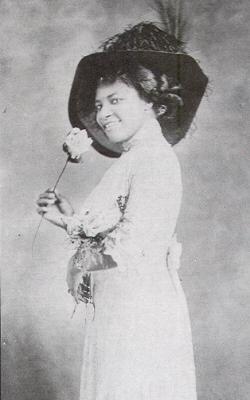BLACK SOCIAL HISTORY
A'Lelia Walker
| BLACK SOCIAL HISTORY |
A'Lelia Walker (June 6, 1885 – August 17, 1931) was an American businesswoman and patron of the arts. She was the daughter and only child of Madam C.J. Walker, popularly credited as being the first self-made woman millionaire in the United States and one of the first African American millionaires.
Early life
A'Lelia Walker was born Lelia McWilliams in Vicksburg, Mississippi, in 1885, the daughter of Moses McWilliams and the woman later known as Madam C. J. Walker. Her father died when she was 2. Her mother later married Charles Joseph Walker, a newspaper advertising salesman, and became an independent hairdresser and retailer of cosmetic creams. A'Lelia grew up in St. Louis, Missouri and attended Knoxville College in Tennessee before entering the family business.[1]
Madame C.J. Walker Manufacturing Company
A'Lelia Walker became president of her mother's company in 1919 and ran it until she died in 1931. She largely lost interest in company affairs after the death of her mother, however, and instead immersed herself in Harlem’s dynamic social life in the 1920s.[1]
Walker Company sales began to suffer in 1929, with the beginning of the Great Depression. Increased expenses associated with a new million dollar headquarters and manufacturing facility opened in late 1927 in Indianapolis, Indiana, placed additional financial pressure on the operation and A’Lelia was forced to sell a great deal of her valuable art and antiques.[1]
Her adopted daughter Mae Walker was president of the company from 1931 until her death in 1945. Mae's daughter, A'Lelia Mae Perry Bundles (1928–1976),[2] succeeded her mother as president of the company. Today the company's building is known as the Madam Walker Theatre Center and is a National Historic Landmark.
Arts patron
A'Lelia Walker counted among her friends many accomplished African American musicians. She developed an early love of classical music and opera in part because the choir director at the AME church she and her mother attended in St. Louis was a classically trained opera singer and organist. She grew up in the neighborhood where Scott Joplin and other ragtime musicians gathered at Tom Turpin's Rosebud Cafe on St. Louis's Market Street.
During the 1920s she hosted many musicians, actors, writers, artists, political figures and socialites in her townhouse at 108-110 West 136th Street near Lenox Avenue.[3] The elegant brick and limestone building had been designed by Vertner Tandy, a founder of Alpha Phi Alpha fraternity and the first black architect licensed in New York State. Almost from the time of her arrival in Harlem in 1913, her dinner parties, dances and soirees included well known Harlem figures like James Reese Europe, J, Rosamand Johnson, Bert Williams and Florence Mills. Live music—from classical and ragtime to jazz and blues—was a regular feature with entertainment provided by her musician friends.
In October 1927, she converted a floor of the home into The Dark Tower, a cultural salon that became legendary as one of the gathering place of the era, a places where Harlem's talented artists socialized with their Greenwich Village counterparts as well as European and African royalty. (Langston Hughes, "The Big Sea" [1940]). She commissioned Austrian designer Paul Frankl to create the interior. She also entertained at Villa Lewaro, her country house in Westchester County and at her pied-a-terre at 80 Edgecomb Avenue in Harlem.
Villa Lewaro was named for Walker (Lelia Walker Robinson) after Italian tenor Enrico Caruso told her after a visit to the property that the newly built Irvington-on-Hudson mansion reminded him of the houses of his native country.
Personal life
She married three times: to John Robinson, a hotel waiter,[4] whom she divorced in 1914; to Dr. Wiley Wilson in 1919; and to Dr. James Arthur Kennedy, in 1926, whom she divorced just a few months before her death in 1931.
She had no biological children, but in 1912 she and Robinson adopted Fairy Mae Bryant (1898–1945), who became known as Mae Walker and traveled with Madam C. J. Walker as a model and assistant.
In November 1923, A'Lelia Walker orchestrated an elaborate "Million Dollar Wedding" (actually closer to $40,000) for Mae's marriage to Dr. Gordon Jackson.[5] Mae Walker, a graduate of Spelman Seminary in Atlanta, divorced Jackson in 1926 and married Attorney Marion R. Perry in September 1927.
Legacy
A'Lelia Walker died on August 17, 1931[6] of a cerebral hemorrhage brought on by hypertension, the same ailment that led to her mother's death in 1919. She was surrounded by friends who had traveled to Long Branch, New Jersey to celebrate a friend's birthday party with lobster and champagne in the midst of the Great Depression and Prohibition.
Thousands of Harlemites lined up to view her body. As her casket was lowered into the ground next to her mother's grave at Woodlawn Cemetery[7] in the Bronx, Hubert Julian —the celebrated "Black Eagle"— flew over in a small plane and dropped dahlias and gladiolas onto the site.
Madam C.J. Walker Building in Indianapolis
The Madam C. J. Walker Company moved from the building in 1985 and the trustees of the Walker estate transferred the building to a non-profit group called the Madam Walker Urban Life Center.[8] Today the building houses a cultural arts organization, is the anchor of the Indiana Avenue Cultural District and is known as the Madame Walker Theatre Center. Its current [2013] president is Jacqueline Morson.[9]

























































































































































No comments:
Post a Comment